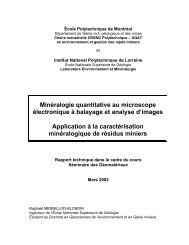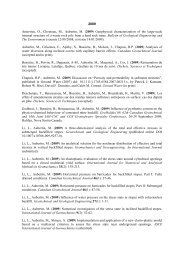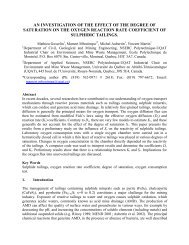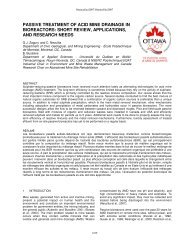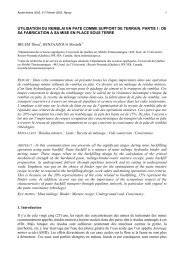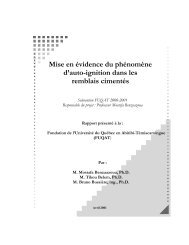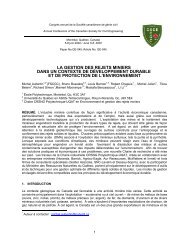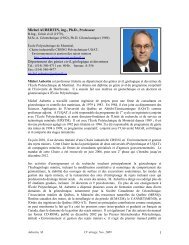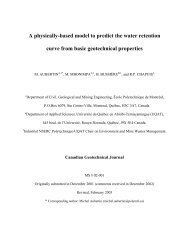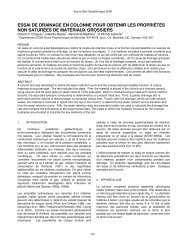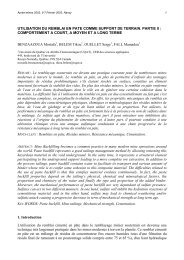Natural Attenuation Potential of Cyanide in Groundwater Near a SPL ...
Natural Attenuation Potential of Cyanide in Groundwater Near a SPL ...
Natural Attenuation Potential of Cyanide in Groundwater Near a SPL ...
You also want an ePaper? Increase the reach of your titles
YUMPU automatically turns print PDFs into web optimized ePapers that Google loves.
<strong>Natural</strong> <strong>Attenuation</strong> <strong>Potential</strong> <strong>of</strong> <strong>Cyanide</strong> <strong>in</strong> <strong>Groundwater</strong> <strong>Near</strong> a <strong>SPL</strong><br />
Landfill<br />
I.Gagnon<br />
Department <strong>of</strong> Chemical Eng<strong>in</strong>eer<strong>in</strong>g, École Polytechnique de Montréal, Montreal, Quebec, Canada<br />
G.J.Zagury<br />
Department <strong>of</strong> Civil, Geological and M<strong>in</strong><strong>in</strong>g Eng<strong>in</strong>eer<strong>in</strong>g, École Polytechnique de Montréal, Montreal,<br />
Quebec, Canada<br />
L.Deschênes<br />
Department <strong>of</strong> Chemical Eng<strong>in</strong>eer<strong>in</strong>g, École Polytechnique de Montréal, Montreal, Quebec, Canada<br />
ABSTRACT: Spent pot l<strong>in</strong><strong>in</strong>g (<strong>SPL</strong>), a waste product conta<strong>in</strong><strong>in</strong>g cyanide, has been deposited <strong>in</strong> a landfill at<br />
an alum<strong>in</strong>um ref<strong>in</strong><strong>in</strong>g site <strong>in</strong> British Columbia (Canada). S<strong>in</strong>ce the capp<strong>in</strong>g <strong>of</strong> the landfill, a cont<strong>in</strong>uous decl<strong>in</strong>e<br />
<strong>of</strong> the cyanide level <strong>in</strong> the groundwater was observed for more than a decade, suggest<strong>in</strong>g that natural<br />
attenuation might be tak<strong>in</strong>g place. The <strong>in</strong>formation gathered from a critical review <strong>of</strong> the exist<strong>in</strong>g literature<br />
along with available groundwater characterization data identified adsorption and biodegradation as two possible<br />
attenuation phenomena. Collection and analysis <strong>of</strong> additional groundwater samples showed that the majority<br />
<strong>of</strong> the cyanide <strong>in</strong> the groundwater was under the form <strong>of</strong> iron-cyanide complexes. Us<strong>in</strong>g the groundwater<br />
characterization data, geochemical model<strong>in</strong>g us<strong>in</strong>g Visual MINTEQ was performed <strong>in</strong> order to predict the<br />
concentration <strong>of</strong> dissolved cyanide species. The results were close to the field data and they confirmed the occurrence<br />
<strong>of</strong> significant concentrations <strong>of</strong> Fe(CN) 6<br />
4-<br />
and Na Fe(CN) 6 3- along the contam<strong>in</strong>ation plume.<br />
1 INTRODUCTION<br />
1.1 Background<br />
<strong>Cyanide</strong> occurs as a groundwater contam<strong>in</strong>ant at<br />
various current and former <strong>in</strong>dustrial sites, <strong>in</strong>clud<strong>in</strong>g<br />
electroplat<strong>in</strong>g facilities, alum<strong>in</strong>um production plants,<br />
manufactured-gas plants (MGP), and gold m<strong>in</strong><strong>in</strong>g<br />
<strong>in</strong>dustries. The study site is located <strong>in</strong> British Columbia<br />
(Canada) and is primarily an alum<strong>in</strong>um<br />
smelter, but also functions as an alum<strong>in</strong>um production<br />
facility.<br />
Spent pot l<strong>in</strong><strong>in</strong>g (<strong>SPL</strong>) is a waste product <strong>of</strong> alum<strong>in</strong>um<br />
ref<strong>in</strong><strong>in</strong>g. It conta<strong>in</strong>s, <strong>in</strong> addition to carbon,<br />
fluoride salts and cyanide. In British Columbia, <strong>SPL</strong><br />
is classified as a special waste by the prov<strong>in</strong>cial<br />
M<strong>in</strong>istry <strong>of</strong> Water, Lands and Air Protection<br />
(MWLAP), and is therefore subject to particular<br />
handl<strong>in</strong>g, storage and transfer requirements. Disposal<br />
<strong>of</strong> <strong>SPL</strong> is an <strong>in</strong>dustry wide problem.<br />
Prior to the mid-1980s, <strong>SPL</strong> from the smelter was<br />
deposited <strong>in</strong> a landfill on the smelter site. The landfill<br />
was capped at the end <strong>of</strong> the 1980s to prevent<br />
leach<strong>in</strong>g <strong>of</strong> cyanide to groundwater. Over the next<br />
decade, a cont<strong>in</strong>uous decl<strong>in</strong>e <strong>of</strong> the cyanide level <strong>in</strong><br />
the groundwater was observed, suggest<strong>in</strong>g that natural<br />
attenuation (NA) might be tak<strong>in</strong>g place. The<br />
ma<strong>in</strong> objectives <strong>of</strong> this study are: (1) to identify the<br />
ma<strong>in</strong> NA phenomena which could expla<strong>in</strong> the cyanide<br />
decrease ; and (2) to assess the NA potential <strong>of</strong><br />
cyanide <strong>in</strong> groundwater near the landfill.<br />
1.2 <strong>Cyanide</strong> chemistry<br />
Speciation <strong>of</strong> the cyanide present <strong>in</strong> groundwater is<br />
very important when determ<strong>in</strong><strong>in</strong>g groundwater toxicity.<br />
<strong>Cyanide</strong>s are toxic and their toxicity is related<br />
to their physicochemical speciation (Zagury et al.<br />
2004). <strong>Cyanide</strong> can exist <strong>in</strong> aqueous solution as free<br />
cyanide (HCN, CN - ) or as complexes with metals<br />
such as cadmium, copper, iron, gold and nickel<br />
among others, or as thiocyanate. Free cyanide, and<br />
weak acid dissociable cyanide (CN WAD ) (complexes<br />
with metals such as copper, z<strong>in</strong>c, nickel) are classified<br />
as the most toxic because <strong>of</strong> their high metabolic<br />
<strong>in</strong>hibition potential whereas strong acid dissociable<br />
cyanide (CN SAD ) (complexes with cobalt,<br />
iron, gold) are considered to be relatively less toxic<br />
(Shifr<strong>in</strong> et al.1996; Zagury et al. 2004). Thiocyanates<br />
are not considered to be very toxic when compared<br />
with cyanide.<br />
Available <strong>in</strong>formation on chemical speciation <strong>of</strong><br />
cyanide <strong>in</strong> contam<strong>in</strong>ated groundwater <strong>in</strong>dicates that<br />
iron-cyanide complexes are <strong>of</strong>ten dom<strong>in</strong>ant (Dzombak<br />
et al. 1996; Meeussen et al. 1992; Theis et al.<br />
1994). These species are stable <strong>in</strong> the dark at neutral<br />
to high pH (Meeussen et al. 1992) and are resistant<br />
to biodegradation (Aronste<strong>in</strong> et al. 1994). However,<br />
Meehan et al. (1999) have shown that cyanide can<br />
be degraded <strong>in</strong> aerobic and anaerobic conditions and<br />
Cherryholmes et al. (1985) observed that K 3 Fe(CN) 6<br />
can be degraded by P. aerug<strong>in</strong>osa <strong>in</strong> the dark. In addition,<br />
at neutral pH conditions, iron cyanide species
exhibit little adsorption onto iron oxides (Theis &<br />
West 1986) but perhaps have greater adsorption on<br />
alum<strong>in</strong>um oxides and kaol<strong>in</strong> clay (Alesii & Fuller<br />
1976), which can be important adsorbents <strong>in</strong><br />
groundwater systems. Ghosh et al. (1999a) <strong>in</strong>vestigated<br />
fate and transport <strong>of</strong> cyanide at a manufactured-gas<br />
plant (MGP) site and their results showed<br />
that cyanide <strong>in</strong> groundwater was primarily <strong>in</strong> the<br />
form <strong>of</strong> iron-cyanide complexes which are transported<br />
as non-reactive solutes <strong>in</strong> the sand-gravel aquifer<br />
material. Also, chemical decomposition <strong>of</strong> iron<br />
cyanide complexes can occur, but the decomposition<br />
k<strong>in</strong>etics are extremely slow.<br />
Free cyanide has been shown to react with various<br />
forms <strong>of</strong> sulphur <strong>in</strong> the environment to form thiocyanate.<br />
The two forms <strong>of</strong> sulphur most likely to react<br />
with cyanide are polysulphides (S 2 ) and thiosulphate<br />
(S 2 O 3 ) (Smith & Mudder 1991). They react<br />
accord<strong>in</strong>g to the follow<strong>in</strong>g equations:<br />
S x -2 + CN - → S (x-1) -2 + SCN - (1)<br />
S 2 O 3 -2 + CN - → SO 3 -2 + SCN - (2)<br />
In neutral to basic solutions, both polysulphides and<br />
thiosulphate are oxidation products <strong>of</strong> sulphides. As<br />
such, these products could possibly be present <strong>in</strong><br />
oxidiz<strong>in</strong>g environments, such as the vadose zone <strong>in</strong><br />
soils. The concentrations <strong>of</strong> polysulphides and thiosulphate<br />
<strong>in</strong> groundwater are strongly dependent on<br />
the sulphur content and the Eh-pH conditions <strong>in</strong> that<br />
groundwater.<br />
1.3 <strong>Natural</strong> attenuation<br />
<strong>Natural</strong> attenuation phenomena such as volatilization,<br />
chelation and precipitation, chemical decomposition,<br />
adsorption, photolytic reactions, and biodegradation<br />
with <strong>in</strong>digenous microorganisms can occur<br />
<strong>in</strong> various environments. In groundwater, volatilization<br />
and photolytic reactions are less likely to occur<br />
and chemical decomposition has very slow k<strong>in</strong>etics.<br />
1.3.1 Adsorption<br />
A key po<strong>in</strong>t <strong>in</strong> the case <strong>of</strong> cyanide is that most aqueous<br />
species are anionic (except HCN), and will<br />
therefore only be sorbed on soils with high anion<br />
exchange capacity. The surfaces <strong>of</strong> most soil particles<br />
have low anion exchange capacity. Retardation<br />
<strong>of</strong> cyanide release due to sorption processes is generally<br />
<strong>of</strong> m<strong>in</strong>or importance <strong>in</strong> most soils (Kjeldsen<br />
1999). However, some surfaces such as Fe, Al and<br />
Mn oxides, clay m<strong>in</strong>erals and organic matter may<br />
provide anion exchange sites (McLean & Bledsoe<br />
1992).<br />
1.3.2 Precipitation<br />
Most <strong>of</strong> the cyanide at alum<strong>in</strong>um plant sites is orig<strong>in</strong>ally<br />
<strong>in</strong> solid form as spent pot l<strong>in</strong><strong>in</strong>g, which conta<strong>in</strong>s<br />
primarily solid cyanide complexes and thiocyanate<br />
compounds. Thiocyanates are quite soluble<br />
<strong>in</strong> water and can produce relatively high thiocyanate<br />
concentrations <strong>in</strong> pores and groundwater. Iron cyanide<br />
complexes are generally slightly soluble. The<br />
potassium and sodium ferrocyanides are readily<br />
soluble, but can reprecipitate <strong>in</strong> the presence <strong>of</strong> iron<br />
(III). The solubility <strong>of</strong> iron cyanide <strong>in</strong> soil is dependent<br />
on pH. Thus, re-precipitation <strong>of</strong> cyanide can<br />
occur if conditions change. The potential for the<br />
cyanide precipitation process to occur can be evaluated<br />
with the use <strong>of</strong> computer-based chemical speciation<br />
models. In this study, model<strong>in</strong>g <strong>of</strong> thermodynamic<br />
equilibrium conditions <strong>in</strong> groundwater<br />
samples collected from four wells will be performed<br />
us<strong>in</strong>g Visual MINTEQ s<strong>of</strong>tware .<br />
Ghosh et al. (1999b) showed that precipitation <strong>of</strong><br />
iron cyanide complexes us<strong>in</strong>g a reactive barrier has<br />
the potential to be used for <strong>in</strong> situ treatment <strong>of</strong> cyanide-contam<strong>in</strong>ated<br />
groundwater.<br />
1.3.3 Microbial degradation<br />
There are many examples <strong>of</strong> cyanide microbial degradation<br />
under both aerobic and anaerobic conditions<br />
(Wang et al. 1996; Barclay et al. 1997). Simple<br />
cyanides, <strong>in</strong> particular, are relatively easily degraded,<br />
especially under aerobic conditions. Degradation<br />
<strong>of</strong> iron cyanides under aerobic conditions also<br />
occurs, but at a slower rate than that <strong>of</strong> simple cyanide<br />
degradation. To our knowledge, bacterial degradation<br />
<strong>of</strong> iron cyanides <strong>in</strong> groundwater under anaerobic<br />
conditions has not yet been <strong>in</strong>vestigated.<br />
Aerobic degradation <strong>of</strong> CN- is mediated by a<br />
number <strong>of</strong> bacteria, fungi, algae, and yeast (Young<br />
& Jordan 1995). The first step <strong>in</strong>volves oxidation <strong>of</strong><br />
cyanide to cyanate:<br />
CN - + ½ O 2 (aq) → OCN - (3)<br />
This is followed by hydrolysis <strong>of</strong> the cyanate, which<br />
requires a pH below 7:<br />
OCN - + 3 H 2 O → NH 4 + + HCO 3 - + OH - (4)<br />
Aerobic degradation <strong>of</strong> CN SAD is mediated by a<br />
number <strong>of</strong> organisms, generally Pseudomonas bacteria<br />
(Young & Jordan 1995). The relevant reaction is:<br />
M(CN) x y-x + 3xH 2 O + x/2 O 2 (aq) → M y+ + x NH 4 + +<br />
x HCO 3 - + xOH - (5)<br />
Thiocyanate is also subject to bacterially-mediated<br />
aerobic degradation:<br />
SCN - + 3H 2 O + 2 O 2 (aq) → SO 4 2- + NH 4 + + HCO 3<br />
-<br />
+ H + (6)<br />
Anaerobic biodegradation <strong>of</strong> cyanide and hydrogen<br />
cyanide is restricted to the moderately to strongly<br />
reduced portions <strong>of</strong> the environment and can only
occur if HS - or H 2 S(aq) are present. The sulphur<br />
species present will depend on pH. At a pH value<br />
greater than 7, HS - is the dom<strong>in</strong>ant species. At a<br />
lower pH, H 2 S(aq) will be present. These equations<br />
illustrate the anaerobic biodegradation <strong>of</strong> cyanide:<br />
CN - + H 2 S (aq) → HCNS + H + (7)<br />
HCN + HS - → HCNS + H + (8)<br />
The HCNS will be hydrolyze to form NH 3 , H 2 S and<br />
CO 2 . In comparison with the aerobic biodegradation<br />
<strong>of</strong> cyanide, anaerobic degradation is much slower<br />
and anaerobic bacteria have a cyanide toxicity<br />
threshold <strong>of</strong> only 2 mg/L compared to 200 mg/L for<br />
aerobic bacteria (Smith & Mudder 1991). Consequently<br />
anaerobic biodegradation would be a less<br />
effective cyanide removal mechanism.<br />
Presumably, natural attenuation may play an important<br />
role <strong>in</strong> cyanide reduction <strong>in</strong> groundwater.<br />
Accord<strong>in</strong>g to Kjeldsen (1999), studies on natural attenuation<br />
<strong>of</strong> cyanide compounds <strong>in</strong> groundwater at<br />
relevant contam<strong>in</strong>ated sites must be carried out.<br />
Few <strong>in</strong>vestigations have been conducted <strong>in</strong> a realistic<br />
soil/groundwater environment. The presence<br />
<strong>of</strong> another substrate, or nutrients, as well as the accessibility<br />
<strong>of</strong> cyanide for the bacteria, can vary<br />
greatly <strong>in</strong> a natural soil/groundwater environment.<br />
Hence, the <strong>in</strong>terest <strong>in</strong> conduct<strong>in</strong>g experiments under<br />
field conditions us<strong>in</strong>g <strong>in</strong>digenous material is evident.<br />
2 CHARACTERIZATION OF WATER<br />
SAMPLES<br />
2.1 Sampl<strong>in</strong>g<br />
<strong>Groundwater</strong> from the study site was sampled at<br />
four different locations (wells PN2A, PN3B,<br />
MW12A, and PZ3) <strong>in</strong> May 2002 and May 2003 <strong>in</strong><br />
order to assess the potential for natural attenuation<br />
near source, middle, end, and just <strong>of</strong>f the contam<strong>in</strong>ation<br />
plume.<br />
2.2 <strong>Groundwater</strong> characterization results<br />
Samples from each <strong>of</strong> the four wells were analyzed<br />
for different physicochemical characteristics and for<br />
various cyanide species accord<strong>in</strong>g to Standard<br />
Methods (Clesceri et al. 1998). The most significant<br />
results obta<strong>in</strong>ed <strong>in</strong> May 2003 are presented <strong>in</strong> Table<br />
1. Results for the four different wells are presented<br />
<strong>in</strong> the same order as the flow direction. This allows<br />
to follow the evolution <strong>of</strong> the contam<strong>in</strong>ation with<strong>in</strong><br />
the plume.<br />
Table 1. Physicochemical properties and concentration <strong>of</strong> cyanide species <strong>in</strong> groundwater (PN2A, PN3B,<br />
MW12A, and PZ3).<br />
FLOW DIRECTION<br />
Well location PN2A PN3 B MW12A PZ3<br />
2003-05- 2003-05- 2003-05-<br />
Sampl<strong>in</strong>g date<br />
12<br />
12<br />
12<br />
2003-05-<br />
12<br />
Units<br />
Dissolved oxygen (<strong>in</strong>-situ) % 0.85 1.09 0.63 1.52<br />
pH (<strong>in</strong>-situ) 9.48 8.84 8.91 6.70<br />
Redox potential (<strong>in</strong>-situ measurement)<br />
MV -72 123 -188 -36<br />
On-site temperature °C 9.3 13.4 9.3 11.2<br />
Dissolved anions<br />
Sulphate mg/l 130 15 32 678<br />
<strong>Cyanide</strong>s<br />
Total cyanide mg/l 4.8 0.056 2.6 0.032<br />
Free cyanide mg/l
Total cyanide values (CN Total ) <strong>in</strong>clude free cyanide,<br />
weak acid dissociable cyanide (CN WAD ) and strong<br />
acid dissociable cyanide (CN SAD ). To obta<strong>in</strong> the<br />
concentration <strong>of</strong> strong metal-cyanide complexes,<br />
free cyanide and CN WAD concentrations must be<br />
substracted from the total cyanide. It should be<br />
noted that thiocyanates are not part <strong>of</strong> the total cyanide<br />
concentration.<br />
2.3 Discussion <strong>of</strong> groundwater characterization<br />
Us<strong>in</strong>g the data presented <strong>in</strong> Table 1 and the conclusions<br />
drawn from the literature review, one can foresee<br />
which cyanide species should be present <strong>in</strong> the<br />
groundwater as well as which attenuation mechanisms<br />
are likely to occur.<br />
Site conditions and species distribution can play a<br />
major role <strong>in</strong> the adsorption/precipitation potential.<br />
For example, pH <strong>in</strong>fluences the sorption potential by<br />
creat<strong>in</strong>g negatively or positively charged surfaces<br />
and redox potential determ<strong>in</strong>es the oxidation state <strong>of</strong><br />
some species (ex. Fe 2+ / Fe 3+ ). Here are some observations<br />
made while analyz<strong>in</strong>g the data obta<strong>in</strong>ed from<br />
the groundwater laboratory characterization:<br />
- CN Total content ranges from 0.03 mg/l<br />
(<strong>of</strong>f the contam<strong>in</strong>ation plume) to 4.8 mg/l<br />
(near source).<br />
- In all wells, CN Total content is far greater<br />
than that obta<strong>in</strong>ed for CN WAD , <strong>in</strong>dicat<strong>in</strong>g<br />
that the majority <strong>of</strong> cyanide <strong>in</strong> groundwater<br />
is under the form <strong>of</strong> strong metal<br />
complexes;<br />
- Of the four ma<strong>in</strong> metals form<strong>in</strong>g strong<br />
metal complexes with cyanide (Fe, Co,<br />
Ag, Au), only Fe is present <strong>in</strong> significant<br />
concentration;<br />
- Two <strong>of</strong> the four wells (PN2A and<br />
MW12A) show a high concentration <strong>of</strong><br />
thiocyanates. These two wells are the<br />
ones hav<strong>in</strong>g the greatest quantity <strong>of</strong> dissolved<br />
organic carbon and the lowest dissolved<br />
oxygen (DO) concentration. Furthermore,<br />
the measured redox potential<br />
was negative <strong>in</strong> these wells;<br />
- <strong>Groundwater</strong> pH is alkal<strong>in</strong>e <strong>in</strong> the plume<br />
and is near neutrality <strong>of</strong>f the plume<br />
(PZ3).<br />
Accord<strong>in</strong>g to the observations stated above and the<br />
detailed analysis, it is possible to assume that the<br />
majority <strong>of</strong> the cyanide (exclud<strong>in</strong>g thiocyanates)<br />
present <strong>in</strong> the groundwater at the four wells is under<br />
the form <strong>of</strong> strong metal complexes because the free<br />
cyanide and weak-acid dissociable cyanide concentrations<br />
are very low. Also, dissolved metals analysis<br />
show that these strong complexes are more likely<br />
to form with iron.<br />
High concentrations <strong>of</strong> thiocyanate at wells<br />
MW12A and PN2A can be expla<strong>in</strong>ed by different<br />
factors. These wells show the highest concentrations<br />
<strong>of</strong> dissolved sulphate and dissolved organic<br />
carbon, and low concentrations <strong>of</strong> dissolved oxygen.<br />
All these characteristics suggest that sulphate reduc<strong>in</strong>g<br />
conditions prevail <strong>in</strong> the groundwater <strong>in</strong> both<br />
wells MW12 and PN2A. Furthermore, dissolved organic<br />
carbon can provide adsorption sites and can<br />
serve as a substrate for bacterial activity.<br />
<strong>Groundwater</strong> characteristics will directly <strong>in</strong>fluence<br />
microbial activity. As mentioned <strong>in</strong> the literature<br />
review, cyanide biological degradation pathways<br />
differ depend<strong>in</strong>g on redox conditions; aerobic<br />
biodegradation occurr<strong>in</strong>g at a much faster rate than<br />
its counterpart. Here are some additional observations<br />
(<strong>in</strong> relation to bacterial activity) made while<br />
analyz<strong>in</strong>g the data obta<strong>in</strong>ed from the groundwater<br />
geochemical characterization:<br />
- Dissolved oxygen concentration <strong>in</strong> the<br />
plume is very low and vary between<br />
0.6 and 1.1 % <strong>of</strong> saturation;<br />
- The well <strong>of</strong>f the plume (PZ3) showed a<br />
relatively elevated DO concentration (3.5<br />
% <strong>in</strong> May 2002).<br />
It will be <strong>in</strong>terest<strong>in</strong>g to study the biological degradation<br />
<strong>of</strong> iron cyanide complexes <strong>in</strong> the groundwater<br />
because this is the dom<strong>in</strong>ant cyanide species. The<br />
wells hav<strong>in</strong>g the lowest redox potentials <strong>in</strong> 2003<br />
(MW12A and PN2A) show elevated thiocyanate and<br />
sulphate concentrations along with high DOC. These<br />
conditions are very suitable for sulfate-reduc<strong>in</strong>g<br />
bacteria activity <strong>in</strong> groundwater.<br />
3 GEOCHEMICAL MODELING USING<br />
VMINTEQ CODE<br />
Us<strong>in</strong>g the results <strong>of</strong> the detailed groundwater characterization,<br />
geochemical model<strong>in</strong>g <strong>of</strong> the groundwater<br />
composition was performed with Visual<br />
MINTEQ. This s<strong>of</strong>tware is used to predict the concentrations<br />
<strong>of</strong> various dissolved species <strong>in</strong> the<br />
groundwater once the thermodynamic equilibrium is<br />
reached. It gives the saturation status, provid<strong>in</strong>g <strong>in</strong>formation<br />
on the probability <strong>of</strong> precipitation.<br />
The model<strong>in</strong>g was performed us<strong>in</strong>g May 2002<br />
data. Accord<strong>in</strong>g to the Visual MINTEQ model<strong>in</strong>g<br />
results, the dom<strong>in</strong>ant cyanide species <strong>in</strong> the groundwater<br />
at each <strong>of</strong> the four wells once thermodynamic<br />
equilibrium has been reached are the follow<strong>in</strong>g:<br />
MW12A - Thiocyanates (SCN - ); PN3B - Free cya-
nide (HCN) and iron cyanide complexes (Fe(CN) 6<br />
4-<br />
and Na Fe(CN) 6 3- ); PN2A - Thiocyanates (SCN - );<br />
PZ3 - Free cyanide (HCN).<br />
In accordance with the results obta<strong>in</strong>ed from the<br />
geochemical characterization, the dom<strong>in</strong>ant species<br />
is thiocyanates <strong>in</strong> wells MW12A and PN2A. It<br />
should be noted that <strong>in</strong> these wells, the dom<strong>in</strong>ant<br />
cyanide species (other than thiocyanates) are<br />
Fe(CN) 6<br />
4-<br />
and Na Fe(CN) 6 3- ). Thiocyanates are quite<br />
soluble <strong>in</strong> water and can produce relatively high<br />
thiocyanate concentrations <strong>in</strong> pores and groundwater<br />
(Kjeldsen 1999), as observed <strong>in</strong> wells PN2A and<br />
MW12A. PZ3, for its part, shows free cyanide<br />
(HCN) as its dom<strong>in</strong>ant cyanide species which can be<br />
expla<strong>in</strong>ed by the groundwater pH <strong>of</strong> 6.2. At such a<br />
pH, more than 99.9 % <strong>of</strong> the free cyanide is under<br />
the form <strong>of</strong> molecular hydrogen cyanide (the pKa is<br />
9.2 at 25 o C).<br />
To help compare the model<strong>in</strong>g results with the<br />
characterization results obta<strong>in</strong>ed <strong>in</strong> the laboratory,<br />
Table 2 shows the concentration <strong>of</strong> various cyanide<br />
species us<strong>in</strong>g the two methods.<br />
The concentrations provided by the model<strong>in</strong>g are<br />
close to those measured <strong>in</strong> the field. The total cyanide<br />
concentrations calculated us<strong>in</strong>g the equilibrium<br />
model<strong>in</strong>g results are slightly higher than those obta<strong>in</strong>ed<br />
dur<strong>in</strong>g the 2002 geochemical characterization.<br />
This result allows the assumption that the reactions<br />
<strong>in</strong> the groundwater under the <strong>SPL</strong> landfill may have<br />
reached a pseudo equilibrium. However, as site conditions<br />
change (ex. pH, redox), equilibrium will shift<br />
and cyanide species concentrations might be different.<br />
The model<strong>in</strong>g does not <strong>in</strong>clude the <strong>in</strong>fluence <strong>of</strong><br />
reaction k<strong>in</strong>etics and the occurrence <strong>of</strong> phenomena<br />
such as sorption and microbial degradation.<br />
Furthermore, the model<strong>in</strong>g results <strong>in</strong>dicate that <strong>in</strong><br />
the contam<strong>in</strong>ation plume, iron cyanide complexes<br />
and specifically Fe(CN) 6<br />
4-<br />
and NaFe(CN) 6 3- are the<br />
dom<strong>in</strong>ant cyanide species. The geochemical model<strong>in</strong>g<br />
<strong>of</strong> the groundwater composition therefore completes<br />
and ref<strong>in</strong>es the groundwater characterization<br />
performed <strong>in</strong> the laboratory.<br />
4 CONCLUSIONS AND FUTURE WORK<br />
Characterization <strong>of</strong> groundwater samples collected<br />
at four different locations (near source, middle,<br />
end, and just <strong>of</strong>f the contam<strong>in</strong>ation plume) <strong>in</strong> the<br />
Spr<strong>in</strong>g <strong>of</strong> 2002 and 2003 showed total cyanide concentrations<br />
(CN Total ) rang<strong>in</strong>g from 0.02 mg l -1 (<strong>of</strong>f<br />
the plume) to 8.9 mg l -1 (near the source <strong>of</strong> the<br />
plume). In all wells, CN Total was far greater than<br />
weak acid dissociable cyanide (CN WAD ) suggest<strong>in</strong>g<br />
that the majority <strong>of</strong> the cyanide <strong>in</strong> the groundwater<br />
was under the form <strong>of</strong> iron-cyanide complexes.<br />
However, the more toxic free cyanide species (HCN,<br />
CN - ) were below detection. Two out <strong>of</strong> the four<br />
wells steadily showed high concentrations <strong>of</strong> thiocyanate<br />
(SCN - ). These wells had conditions very<br />
suitable for sulfate-reduc<strong>in</strong>g bacteria activity (high<br />
dissolved sulphate and dissolved organic carbon<br />
concentrations, and low concentrations <strong>of</strong> dissolved<br />
oxygen).<br />
Us<strong>in</strong>g the groundwater characterization data,<br />
geochemical model<strong>in</strong>g with Visual MINTEQ was<br />
performed <strong>in</strong> order to predict the concentration <strong>of</strong><br />
dissolved cyanide species at thermodynamic equilibrium.<br />
The results were close to the field data and<br />
they confirmed the occurrence <strong>of</strong> significant concentrations<br />
<strong>of</strong> Fe(CN) 6 and NaFe(CN) 4- 6 along the<br />
4-<br />
contam<strong>in</strong>ation plume. Further model<strong>in</strong>g will be<br />
performed with the 2003 data, to better understand<br />
the fate <strong>of</strong> cyanide.<br />
The results <strong>of</strong> the groundwater characterization<br />
and the geochemical equilibrium model<strong>in</strong>g enabled<br />
us to identify the ma<strong>in</strong> natural attenuation phenomena<br />
which should be tested <strong>in</strong> the laboratory. Adsorption<br />
and microbial degradation will be <strong>in</strong>vestigated.<br />
The adsorption potential will be assessed us<strong>in</strong>g<br />
batch and column experiments. Available geological<br />
material from the site will be used along with<br />
groundwater from the site and synthetic cyanidecontam<strong>in</strong>ated<br />
water.<br />
Heterotrophic and cyanide-resistant bacteria<br />
counts will be performed to <strong>in</strong>vestigate the presence<br />
<strong>of</strong> <strong>in</strong>digenous micr<strong>of</strong>lora <strong>in</strong> groundwater. Microbial<br />
degradation <strong>of</strong> iron cyanide complexes and free cyanide<br />
will be evaluated us<strong>in</strong>g radiolabeled m<strong>in</strong>eralization<br />
tests <strong>in</strong> microcosms (Oudjehani et al. 2002).<br />
Upon completion <strong>of</strong> these experiments, we should<br />
have a better understand<strong>in</strong>g <strong>of</strong> cyanide fate and natural<br />
attenuation potential <strong>in</strong> the groundwater near<br />
spent pot l<strong>in</strong><strong>in</strong>g landfills.<br />
Table 2. Total cyanide, strong acid dissociable cyanide and SCN - <strong>in</strong> groundwater (mg/l) follow<strong>in</strong>g laboratory<br />
characterization and thermodynamic model<strong>in</strong>g.
* Calculated as the difference between total cyanide and WAD cyanide<br />
** Calculated by summ<strong>in</strong>g every WAD, SAD and free cyanide species concentration<br />
5 REFERENCES<br />
Alesii, B.A. and Fuller, W.H. 1976. The Mobility <strong>of</strong> Three<br />
<strong>Cyanide</strong> Forms <strong>in</strong> Soils, Proceed<strong>in</strong>gs <strong>of</strong> the Hazardous<br />
Waste Research Symposium, C<strong>in</strong>c<strong>in</strong>nati: U.S. Environmental<br />
Protection Agency.<br />
Aronste<strong>in</strong>, B.N., Lawal, R.A. and Maka A. 1994. Chemical<br />
Degradation <strong>of</strong> <strong>Cyanide</strong>s by Fenton's Reagent <strong>in</strong> Aqueous<br />
and Soil-Conta<strong>in</strong><strong>in</strong>g Systems. Environmental Toxicology &<br />
Chemistry 13(11): 1719-1726.<br />
Barclay, M., Tette, V.A., Knowles, C.J., Hart, A. and Sharman,<br />
A.K. 1997. Biodegradation <strong>of</strong> Metal-Complexes <strong>Cyanide</strong>s<br />
by Fusarium Solani. In Situ and On-Site Bioremediation<br />
Symposium. 2: 531.<br />
Cherryholmes, K.L., Cornils, W.J., McDonald, D.B. and<br />
Spl<strong>in</strong>ter, R.C. (Cardwell, Purdy and Bahner) 1985. Biological<br />
Degradation <strong>of</strong> Iron <strong>Cyanide</strong> In <strong>Natural</strong> Aquatic Systems.<br />
Aquatic Toxicology and Hazard Assessment, 7th<br />
symposium ASTM STP 854, Philadelphia: American Society<br />
for Test<strong>in</strong>g Materials.<br />
Clesceri LS, Greenberg AE, Eaton AD (eds) 1998. Standard<br />
methods for the exam<strong>in</strong>ation <strong>of</strong> water and wastewater. 20 th<br />
Edition. Wash<strong>in</strong>gton, USA.<br />
Dzombak, D.A., Dobbs, C.L., Culleiton, C.J., Smith, J.R. and<br />
Krause, D. 1996. Removal <strong>of</strong> <strong>Cyanide</strong> from Spent Pot<br />
L<strong>in</strong><strong>in</strong>g Leachate by Iron <strong>Cyanide</strong> Precipitation. Proc. Water<br />
Environ. Fed. 69th Ann. Conf. Exposition: 107-116.<br />
Ghosh, R.S., Dzombak, D.A., Luthy, R.G. and Nakles, D.V.<br />
1999a. Subsurface Fate and Transport <strong>of</strong> <strong>Cyanide</strong> Species<br />
at a Manufactured-Gas Plant Site. Water Environment Research<br />
71(6): 1205-1216.<br />
Ghosh, R.S., Dzombak, D.A., Luthy, R.G. and Smith, J.R.<br />
1999b. In Situ Treatment <strong>of</strong> <strong>Cyanide</strong>-Contam<strong>in</strong>ated<br />
<strong>Groundwater</strong> by Iron <strong>Cyanide</strong> Precipitation. Water Environment<br />
Research 71(6): 1217-1228.<br />
Kjeldsen, P. 1999. Behaviour <strong>of</strong> <strong>Cyanide</strong>s <strong>in</strong> Soil and<br />
<strong>Groundwater</strong>: A Review. Water, Air, & Soil Pollution 115:<br />
279-307.<br />
McLean, J.E. and Bledsoe, B.E. 1992. Behavior <strong>of</strong> Metals <strong>in</strong><br />
Soils. US EPA/540/S-92/018.<br />
Meehan, S.M.E., Weaver, T.R. and Lawrence, C.R. 1999. The<br />
Biodegradation <strong>of</strong> <strong>Cyanide</strong> <strong>in</strong> <strong>Groundwater</strong> at Gasworks<br />
Sites, Australia: implications for site management. Environmental<br />
Management & Health 10(1): 64-71.<br />
Meeussen, J.C.L., Keizer, M.G. and de Haan, F.A.M. 1992.<br />
Chemical Stability and Decomposition Rate <strong>of</strong> Iron <strong>Cyanide</strong><br />
Complexes In Soil Solutions. Environmental Science<br />
& Technology 26(3): 511-516.<br />
Oudjehani, K., Zagury, G.J. and Deschênes, L. 2002. <strong>Natural</strong><br />
<strong>Attenuation</strong> <strong>Potential</strong> <strong>of</strong> <strong>Cyanide</strong> via Microbial Activity <strong>in</strong><br />
M<strong>in</strong>e Tail<strong>in</strong>gs. Applied Microbiology & Biotechnology,<br />
58(3): 409-415.<br />
Shifr<strong>in</strong>, N.S., Beck, B.D., Gauthier, T.D., Chapnick, S.D. and<br />
Goodman, G. 1996. Chemistry, Toxicology, and Human<br />
Health Risk <strong>of</strong> <strong>Cyanide</strong> Compounds <strong>in</strong> Soils at Former<br />
Manufactured Gas Plant Sites. Regulatory Toxicology &<br />
Pharmacology, 23(2): 106-116.<br />
Smith, A., and Mudder T. 1991. The chemistry and treatment<br />
<strong>of</strong> cyanidation wastes, London: M<strong>in</strong><strong>in</strong>g Journal Books Ltd.<br />
Theis, T. L., Young, T.C., Huang, M. and Knutsen K.C. 1994.<br />
Leachate Characteristics and Composition <strong>of</strong> <strong>Cyanide</strong>-<br />
Bear<strong>in</strong>g Wastes from Manufactured Gas Plants. Environmental<br />
Science & Technology 28(1): 99-106.<br />
Theis, T. L., and West, M.J. 1986. Effects <strong>of</strong> <strong>Cyanide</strong> Complexation<br />
on Adsorption <strong>of</strong> Trace Metals at the Surface <strong>of</strong><br />
Goethite. Environmental Technology Letters 7: 309-318.<br />
Wang, C.-S., Kunz, D.A. and Venables, B.J. 1996.<br />
Incorporation <strong>of</strong> Molecular Oxygen and Water dur<strong>in</strong>g Enzymatic<br />
Oxidation <strong>of</strong> <strong>Cyanide</strong> by Pseudomonas fluorescens<br />
NCIMB 11764. Applied & Environmental Microbiology,<br />
62(6): 2195-2197.<br />
Young, C. A. and Jordan, T.S. (L. E. Erickson, D. L. Tillison,<br />
S. C. Grant and J. P. McDonald) 1995. <strong>Cyanide</strong> Remediation:<br />
Current and Past Technologies, 10th Annual Conference<br />
on Hazardous Waste Research, Manhattan (Kansas):<br />
Kansas State University.<br />
Zagury, G. J., Oudjehani, K. and Deschênes, L. 2004. Characterization<br />
and availability <strong>of</strong> cyanide <strong>in</strong> solid m<strong>in</strong>e tail<strong>in</strong>gs<br />
from gold extraction plants. The Science <strong>of</strong> the Total<br />
Environment, (<strong>in</strong> press).<br />
Sampl<strong>in</strong>g Wells Laboratory characterization (May 2002<br />
sampl<strong>in</strong>g campaign)<br />
Model<strong>in</strong>g results (Visual MINTEQ)<br />
Total CN *CN SAD SCN - **Total CN Iron-cyanide SCN -<br />
Complexes<br />
PN2A 8.9 8.83 185 12.7 12.7 184.78<br />
PN3B 0.584 0.576 < 5 0.696 0.512 5.8E-18<br />
MW12A 3.2 3.176 17 4.33 2.37 16.98<br />
PZ3 0.02 0.02 < 0.5 0.021 < 10 -5 5.8E-18



